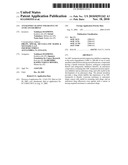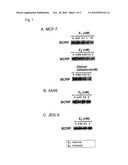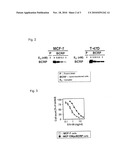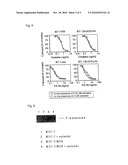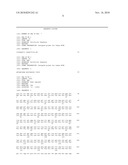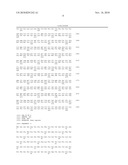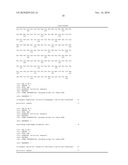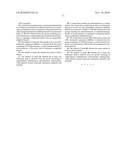Patent application title: ANTAGONIST AGAINST TOLERANCE TO ANTICANCER DRUGS
Inventors:
Yoshikazu Sugimoto (Kashiwa-Shi, JP)
Satomi Tsukahara (Shibuya-Ku, JP)
Yasuo Imai (Bunkyo-Ku, JP)
Assignees:
Yoshikazu SUGIMOTO
JAPANESE FOUNDATION FOR CANCER RESEARCH
KABUSHIKI KAISHA YAKULT HONSHA
IPC8 Class: AA61K3624FI
USPC Class:
424725
Class name: Drug, bio-affecting and body treating compositions plant material or plant extract of undetermined constitution as active ingredient (e.g., herbal remedy, herbal extract, powder, oil, etc.)
Publication date: 2010-11-18
Patent application number: 20100291242
Claims:
1-13. (canceled)
14. A method for treating cancer, comprising administering to a subject in need thereof an effective amount of a composition comprising at least one anticancer drug and at least one ABC transporter expression inhibitor present in an amount of 0.001 to 100 nM selected from the group consisting of a steroid hormone, a compound having a female hormone function, an analogous compound thereof and an antagonistic inhibitor thereof.
15. The method of claim 14, wherein the at least one ABC transporter expression inhibitor is selected from the group consisting of a follicle hormone, a corpus luteum hormone, a nortestosterone, a flavonoid, and an analogous compound thereof.
16. The method of claim 14, wherein the cancer is breast cancer.
17. The method of claim 14, wherein the at least one anticancer drug is selected from the group consisting of camptothecin, anthraquinone, staurosporine, anthracycline, vinka alkaloid, taxane, etoposide, mitomycin, gefinitib, and imanitib.
18. A composition suitable for administration to a cancer patient, the composition comprising at least one anticancer drug and at least one ABC transporter expression inhibitor present in an amount of 0.001 to 100 nM selected from the group consisting of a steroid hormone, a compound having a female hormone function, an analogous compound thereof and an antagonistic inhibitor thereof.
19. The composition of claim 18, wherein the at least one ABC transporter expression inhibitor is selected from the group consisting of a follicle hormone, a corpus luteum hormone, a nortestosterone, a flavonoid, and an analogous compound thereof.
20. The method of claim 18, wherein the cancer patient is a breast cancer patient.
21. The method of claim 18, wherein the at least one anticancer drug is selected from the group consisting of camptothecin, anthraquinone, staurosporine, anthracycline, vinka alkaloid, taxane, etoposide, mitomycin, gefinitib, and imanitib.
Description:
TECHNICAL FIELD
[0001]The present invention relates to anticancer drugs which are effective against cancer that has acquired anticancer drug resistance and to cells which are useful for developing such anticancer drugs.
BACKGROUND ART
[0002]Anticancer drugs such as camptothecins (e.g., irinotecan hydrochloride) and mitoxantrone exhibit surprisingly excellent effect against malignant tumors and thus have been widely employed in clinical settings. However, researchers have pointed out that a prolonged and continuous use of those drugs sometimes result in a reduction in efficacy. Recent research on the mechanism with which cancer cells acquire resistance to the anticancer drugs has revealed that BCRP, which is an ABC transporter, participates in the acquisition of anticancer drug resistance (Non-Patent Document 1). Specifically, according to the findings of the research, after a prolonged continuous use of an anticancer drug, BCRP comes to be expressed in cancer cells, and the BCRP discharges the anticancer drug out of the cells to thereby reduce the amount of anticancer drug accumulated within the cells. In this connection, p-glycoprotein encoded by MDR1 gene is also known as an ABC transporter which participates in the acquisition of anticancer drug resistance (Non-Patent Document 2). P-glycoprotein has two ATP-binding cassettes and exhibits substrate specificity different from that of BCRP.
Non-Patent Document 1: Proc. Natl. Acad. Sci. USA, 95(26), 15665-15670 (1998)
Non-Patent Document 2: Methods in Enzymology, 292: 248-594 (1998)
DISCLOSURE OF THE INVENTION
Problems to be Solved by the Invention
[0003]Until today, researchers have failed to identify a low-molecular-weight compound that can prevent expression of an ABC transporter in cancer cell lines that have come to acquire anticancer drug resistance as a result of expression, or elevated expression, of the ABC transporter, and, no useful experimental system has been established. Therefore, researchers could not develop means for overcoming anticancer drug resistance, on the basis of suppression of expression of an ABC transporter.
[0004]Accordingly, the present invention provides a drug which overcomes anticancer drug resistance by preventing expression of an ABC transporter; cancer cells useful for screening candidate drugs to identify a drug which overcomes, through prevention of expression of an ABC transporter, anticancer drug resistance; and an anticancer drug which is efficacious against a cancer that has acquired anticancer drug resistance.
Means for Solving the Problems
[0005]The present inventors have carried out screening of a variety of substances with an aim to identify a compound capable of preventing expression of BCRP through use of cancer cells which intrinsically express ABC transporters at high level, in particular BCRP at high level, and have found that very low levels of a steroid hormone, a compound having a female hormone function, an analogous compound thereof, and an antagonistic inhibitor therefor effectively lower expression of BCRP in MCF-7 cells having female hormone receptors.
[0006]The present inventors have also studied transfer of BCRP gene by using breast cancer cells bearing female hormone receptors, such as MCF-7 and T-47D, and have successfully established breast cancer cells which contain exogenous BCRP gene and which have acquired anticancer drug resistance. The inventors have further studied transfer of p-glycoprotein gene by using cells such as MCF-7 and T-47D, and have successfully established breast cancer cells which contain exogenous p-glycoprotein gene and which have acquired anticancer drug resistance.
[0007]Moreover, the present inventors have discovered that expression of BCRP or p-glycoprotein in breast cancer cells is reduced by a very low level of a steroid hormone, a compound having a female hormone function, an analogous compound thereof, or an antagonistic inhibitor therefor, to thereby effectively overcome the anticancer drug resistance. The present invention has accomplished on the basis of this finding.
[0008]Accordingly, the present invention provides an ABC transporter protein expression inhibitor comprising, as active ingredient(s) thereof, 0.001 to 100 nM of one or more members selected from among steroid hormones, compounds having a female hormone function, analogous compounds thereof and antagonistic inhibitors therefor.
[0009]The present invention also provides an anticancer composition containing such an ABC transporter protein expression inhibitor and an anticancer drug.
[0010]The present invention also provides breast cancer cells MCF-7 which exhibit resistance against 7-ethyl-10-hydroxycamptothecin (SN-38) and express BCRP at high level; breast cancer cells T-47D which exhibit resistance against 7-ethyl-10-hydroxycamptothecin (SN-38) and express BCRP at high level; breast cancer cells MCF-7 which exhibit resistance against vincristine and express p-glycoprotein at high level; and breast cancer cells T-47D which exhibit resistance against vincristine and express p-glycoprotein at high level.
[0011]The present invention further provides a method for screening ABC transporter protein expression inhibitors, which comprises using, as an indicator, expression level of BCRP or p-glycoprotein in the above-described breast cancer cells exhibiting resistance against 7-ethyl-10-hydroxycamptothecin (SN-38) or in breast cancer cells exhibiting vincristine resistance.
EFFECTS OF THE INVENTION
[0012]The present invention can recover the effect of anticancer drugs which are prevented from exhibiting sufficient drug efficacy because of an ABC transporter (in particular, BCRP) or p-glycoprotein being expressed. Thus, dosage of anticancer drugs can be easily controlled, to thereby realize cancer chemotherapy with minimized adverse side effects.
[0013]The invention also enables retrieval of compounds which effectively suppress expression of BCRP or p-glycoprotein, and provides a drug development system useful for elucidating the action mechanism of the retrieved compounds.
BRIEF DESCRIPTION OF THE DRAWINGS
[0014]FIG. 1 shows suppressive effect of estrone, estradiol, and diethylstilbestrol on expression of endogenous BCRP.
[0015]FIG. 2 shows suppressive effect of estradiol on expression of exogenous BCRP.
[0016]FIG. 3 shows the results of a cell growth inhibition test performed by using SN-38 on MCF-7 cells or MCF-7/MycBCRP cells.
[0017]FIG. 4 shows the results of a cell growth inhibition test performed by using SN-38 or vincristine on MCF-7 cells or MCF-7/MycBCRP cells in the presence of estradiol.
[0018]FIG. 5 shows inhibiting effect of estradiol on expression of p-glycoprotein.
BEST MODE FOR CARRYING OUT THE INVENTION
[0019]The present invention will be described focusing on a typical ABC transporter, BCRP.
[0020]A steroid hormone, a compound having a female hormone function, or a similar compound was added to respective cells of MCF-7 (breast cancer), A549 (lung adenocarcinoma), and JEG-3(placental choriocarcinoma), which intrinsically express BCRP at high level. As a result, as shown in Example 1, significant reduction in expression level of BCRP was observed only in MCF-7 cells expressing female hormone receptors.
[0021]Next will be described cancer cells harboring an exogenous BCRP gene.
[0022]The BCRP gene which may be transferred to cancer cells has already been registered (DDBJ accession number AB056867). It is also described in the literature (see, for example, Doyle, L. A., Yang, W., Abruzzo, L. V., Krogmann, T., Gao, Y., Rishi, A. K. and Ross, D. D. "A multidrug resistance transporter from human MCF-7 breast cancer cells" Proc. Natl. Acad. Sci. U.S.A. 95(26), 15665-15670 (1998)). No particular limitation is imposed on the BCRP gene so long as expression of BCRP is attained. For example, the following may be employed: a retrovirus-vector-inserted plasmid; i.e., pHaBCRP or pHa-BCRP-IRES-DHFR. More specifically, an especially preferred plasmid is constructed by inserting a Myc-epitope-tagged BCRP into a retrovirus vector.
[0023]Examples of preferred cancer cells include MCF-7 and T-47D cell, for the reasons that they express female hormone receptors, that they are easily cultured, and that they show sensitivity to anticancer drugs which are transported by BCRP.
[0024]An exogenous BCRP gene can be easily transferred to cancer cells according to a routine procedure, using a BCRP-gene-inserted retrovirus or a similar material.
[0025]The resultant exogenous-BCRP-gene-harboring cancer cells have acquired anticancer drug resistance, as proven by expression of BCRP and reduced intracellular uptake of anticancer drug. Therefore, the cells are useful for screening ABC transporter protein expression inhibitors. In particular, breast cancer cells that express BCRP produced through gene transfer by using a retrovirus are very useful in studies to overcome anticancer drug resistance caused by BCRP, because, as compared with parent cells, they do not affect other anticancer drug resistance genes such as MDR1 and MRP, and they are convenient in terms of handling. Such cells may be directly screened in vitro. Alternatively, they may be first transplanted to an animal such as mice, followed by in vivo screening.
[0026]Specific examples of cells which may be used for screening include breast cancer cells MCF-7 which exhibit resistance against 7-ethyl-10-hydroxycamptothecin (SN-38) and express BCRP at high level; breast cancer cells T-47D which exhibit resistance against 7-ethyl-10-hydroxycamptothecin (SN-38) and express BCRP at high level; breast cancer cells MCF-7 which exhibit resistance against vincristine and express p-glycoprotein at high level; and breast cancer cells T-47D which exhibit resistance against vincristine and express p-glycoprotein at high level.
[0027]The screening method of the present invention may be carried out as follows: breast cancer cells which exhibit resistance against 7-ethyl-10-hydroxycamptothecin (SN-38) and express BCRP at high level or breast cancer cells which exhibit resistance against vincristine and express p-glycoprotein at high level are cultured in the presence or absence--with other culture conditions being unchanged--of a test substance; subsequently, select, as an ABC transporter protein expression inhibitor, a test substance which brings a reduction in expression level of BCRP or p-glycoprotein.
[0028]Examples of the breast cancer cells include breast cancer cells MCF-7 and breast cancer cells T-47D. The concentration of the test substance employed for culturing is preferably 0.0001 to 100 nM, more preferably, 0.01 to 10 nM. Cultivation is carried out for, for example, 2 to 5 days. The expression level of BCRP or p-glycoprotein can be determined through, for example, Western blotting.
[0029]The above-produced cells were employed. Specifically, a steroid hormone, a compound having a female hormone function, or a similar compound was added to MCF-7 cells or T-47D cells harboring an exogenous BCRP gene. As a result, as shown in Example 2 provided hereinbelow, expression level of BCRP was significantly reduced, revealing that sensitivity to an anticancer drug; i.e., cancer cell growth inhibitory effect provided by an anticancer drug, can be recovered. Accordingly, the mentioned compounds are useful as ABC transporter protein expression inhibitors in cancer cells.
[0030]As used herein, preferred substances from among the steroid hormones, female hormones, their analogues, and antagonistic inhibitors therefor are female hormones and their analogues. Specific examples include follicle hormones such as estrone, estradiol, estradiol benzoate, estradiol dipropionate, estradiol valerate, ethinylestradiol, estriol, estriol acetate benzoate, estriol tripropionate, conjugated estrogens, mestranol, diethylstilbestrol, diethylstilbestrol dipropionate, fosfestrol, estramustine sodium phosphate, and their analogues; corpus luteum hormones such as progesterone, pregnenolone, pregnanediol, dydrogesterone, hydroxyprogesterone caproate, hydroxyprogesterone acetate, chlormadinone acetate, allylesterenol, and gestonorone caproate, and their analogues; nortestosterones such as norethisterone and allylsterol, and their analogues; and flavonoids such as genistein and naringenin, and their analogues.
[0031]The concentration of the above-listed female hormones and their analogues in ABC transporter protein expression inhibitors of the present invention is preferably 0.001 to 100 nM, more preferably 0.01 to 10 nM.
[0032]No particular limitation is imposed on anticancer drugs with which the ABC transporter protein expression inhibitor of the present invention is useful, so long as they are anticancer drugs which exhibit resistance induced by BCRP or p-glycoprotein. Examples of useful anticancer drugs include camptothecins such as irinotecan hydrochloride, topotecan, and topotecin; anthraquinones such as mitoxantrone; staurosporines such as 7-hydroxystaurosporine; anthracyclines such as doxorubicin hydrochloride, Daunomycin, epirubicin hydrochloride, and adriamycin; vinka alkaloids such as vincristine; taxanes such as paclitaxel and docetaxel; and etoposide, mitomycin, gefinitib, and imanitib.
[0033]No particular limitation is imposed on the cancer targeted by the ABC transporter protein expression inhibitor of the present invention, so long as the aforementioned anticancer drugs are used for treatment. However, the cancer cells express hormone receptors, in particular female hormone receptor, are preferred.
[0034]When (A) an ABC transporter protein expression inhibitor of the present invention is used in combination with (B) an anticancer drug which exhibits acquired cancer cell resistance, therapeutic effect against the cancer that has acquired drug resistance can be recovered, so that a composition containing these ingredients (A) and (B) is useful as a novel anticancer drug.
[0035]The ABC transporter protein expression inhibitor of the present invention or the novel anticancer drug of the present invention may be administered in such a way that conventional agents, each conventionally containing the above ingredients, may be administered in combination. Alternatively, by incorporating the above two ingredients, a new drug product may be produced. Exemplary product forms include oral administration form, injection form (including intramuscular, subcutaneous, and intravenous), suppositories, and external-use form (patches, paints, etc.).
[0036]Dose of the ABC transporter protein expression inhibitor of the present invention varies depending on the manner of administration, pathological conditions, etc. A daily dose of 0.1 to 10 mg is preferred. The dose of an anticancer drug (B) which develops drug resistance in cancer cells may be an ordinary efficacy-providing dose; for example, 1 mg to 1 g, in particular 2 to 300 mg.
EXAMPLES
[0037]The present invention will next be described in detail by way of Examples, which should not be construed as limiting the invention thereto.
Example 1
Suppression of Expression of Endogenous BCRP
[0038]Western blotting was performed to investigate the effect of a steroid hormone and a female hormone on MCF-7, A549, and JEG-3 cells, which intrinsically express BCRP at high level, in terms of the expression level of BCRP. Estrone or estradiol was added to a phenol red-free DMEM medium containing fetal bovine serum (7%) which had been treated with activated carbon to remove steroids, and incubation was performed for 4 days. Afterwards, expression level of BCRP was determined through the Western blotting technique using an anti-BCRP antibody. In each lane, 30 μg of protein was electrophoresed.
[0039]In the presence of estrone or estradiol, expression level of endogenous BCRP in MCF-7 cells decreased to 10 to 20% the level as measured for control. However, in other cells, no such changes were observed (FIG. 1).
Example 2
(1) BCRP Gene
[0040]In the present invention, human BCRP cDNA, which had been isolated from human placenta mRNA through PCR, was employed. In PCR, the materials employed were human placenta Marathon-ready cDNA (Clontech Co.) (as a template); 5'-side primer 1S of human BCRP cDNA (CCT GAG ATC CTG AGC CTT TGG TT) (SEQ ID No: 1) and 3'-side primer 5AS of human BCRP cDNA (GAT GGC AAG GGA ACA GAA AAC AAC A) (SEQ ID No: 2) (as two oligonucleotides serving as primers); and an Advantage cDNA PCR kit (Clontech Co.). The PCR conditions were as follows: 1×94° C. (1 min)→35×{94° C. (30 sec)+68° C. (3 min)}→1×{94° C. (30 sec)+68° C. (15 min)}. As a result, an amplified cDNA of about 2,150 by was obtained. The thus-obtained cDNA was subcloned into a PCR2.1 plasmid, and the nucleotide sequence of the cDNA was determined by means of ABI PRISM377 DNA sequencer (Applied Biosystems Co.). Sequencing of mutually independent 4 clones was performed. With any portions considered to be PCR-induced mutations having been disregarded, the nucleotide sequence of the coding region of the present gene was determined (SEQ ID No: 3). An amino acid sequence deduced therefrom is shown by SEQ ID No: 4. In the present invention, this sequence is referred to as the sequence of a wild-type BCRP. The sequence of BCRP according to the present invention is registered as DDBJ accession number AB056867 and described in JP-A-2003-63989.
(2) Preparation of BCRP-Expressing Plasmid
[0041]Next, PCR was performed again in order to modify the end of the sequence so as to enable insertion of a Myc-epitope-tagged BCRP cDNA. When the PCR for addition of a Myc epitope tag was carried out, the following materials were employed: human BCRP cDNA obtained from the above PCR (as a template); 5'-side primer 5Myc-204S containing Myc epitope tag (CCC CGC GGC ATG GAA CAA AAA CTC ATC TCA GAA GAG GAT CTG TCT TCC AGT AAT GTC GAA GTT TTT ATC CCA GTG TC) (SEQ ID No: 5) and 3'-side primer 8AS (CGC CTC GTG GAT GGC AAG GGA ACA GAA AAC AAC A) (SEQ ID No: 6) (as two oligonucleotides serving as primers); and an Advantage cDNA PCR kit (Clontech Co.). The PCR conditions were as follows: 1×94° C. (1 min)→20×{94° C. (30 sec)+68° C. (3 min)}→1×{94° C. (30 sec)+68° C. (15 min)}. As a result, an amplified cDNA of about 2,200 by was obtained. The amplified cDNA was subjected to subcloning to thereby determine the nucleotide sequence and confirm that no PCR-induced mutation was present. When the PCR for addition of an HA epitope tag was carried out, the following materials were employed: human BCRP cDNA obtained from the above PCR (as a template); 5'-side primer 5HA-204S containing an HA epitope tag (CCC CGC GGC ATG TAC CCA TAC GAC GTC CCA GAC TAO GCT ATG TCT TCC AGT AAT GTC GAA GTT TTT ATC CCA GTG TC) (SEQ ID No: 7) and 3'-side primer 8AS (CGC CTC GTG GAT GGC AAG GGA ACA GAA AAC AAC A) (SEQ ID No: 6) (as two oligonucleotides serving as primers); and an Advantage cDNA PCR kit (Clontech Co.). The PCR conditions were as follows: 1×94° C. (1 min)→20×{94° C. (30 sec)+68° C. (3 min)}→1×{94° C. (30 sec)+68° C. (15 min)}. As a result, an amplified cDNA of about 2,200 by was obtained. The amplified cDNA was subjected to subcloning to thereby determine the nucleotide sequence and confirm that no PCR-induced mutation was present.
[0042]Both ends of each cDNA were digested with two restriction enzymes SstII and XhoI and were subsequently subjected to ligation with a pHa plasmid vector digested with SstII and XhoI by use of a T4 DNA ligase. The ligation reaction mixture was added to E. coli DH5a, to thereby yield clones pHaMycBCRP and pHaHABCRP, which have BCRP cDNA inserted between the SstII site and XhoI site of the pHa plasmid vector.
(3) Preparation of BCRP Retrovirus
[0043]Firstly, calcium phosphate transfection was performed to transfer pHaMycBCRP and pHaHABCRP to PA317 cells belonging to a mouse amphotropic retrovirus packaging cell line. Cells which had undergone gene transfer were subjected to selection with 1-ng/mL mitoxantrone, whereby gene-transferred cells were obtained. The supernatant of the cell culture was collected and filtered with a 0.45-μm filter, to thereby obtain a retrovirus liquid.
(4) Preparation of MCF-7/MycBCRP Cell
[0044]A MycBCRP retrovirus liquid was added to a culture broth of human breast cancer MCF-7 cells, whereby gene transfer was performed. Retrovirus-added cells were selected using 20-ng/mL SN-38 (7-ethyl-10-hydroxycamptothecin: an active form of irinotecan hydrochloride), to thereby produce gene-transferred cells. The cells were named MCF-7/MycBCRP. MCF-7 cells and MCF-7/MycBCRP cells were cultured in DMEM medium supplemented with 7% fetal bovine serum. Western blotting using anti-Myc antibody confirmed that BCRP protein was expressed in MCF-7/MycBCRP cells (FIG. 2). In each lane, 20 μg of protein was electrophoresed. MCF-7 cells, which are human breast cancer cells, constitute a suitable parent strain of BCRP-gene transferred cells for the reasons that they intrinsically express female hormone receptors, that they can be easily cultured, and that they exhibit sensitivity to anticancer drugs transported by BCRP, such as mitoxantrone and irinotecan hydrochloride. Also, MCF-7 cells and MCF-7/MycBCRP cells can be transplanted to immunodeficient mice to thereby perform animal experiments of BCRP inhibitors and like substances.
(5) Preparation of T-47D/MycBCRP Cell
[0045]A MycBCRP retrovirus liquid was added to a culture broth of human breast cancer T-47D cells, whereby gene transfer was performed. Retrovirus-added cells were selected using 10-ng/mL SN-38, to thereby produce gene-transferred cells. The cells were named T-47D/MycBCRP. T-47D cells and T-47D/MycBCRP cells were cultured in DMEM medium supplemented with 7% fetal bovine serum. Western blotting using anti-BCRP antibody confirmed that BCRP protein was expressed in T-47D/MycBCRP cells (FIG. 2). T-47D cells, which are human breast cancer cells, constitute a suitable parent strain of BCRP-gene transferred cells for the reasons that they intrinsically express no BCRP, that they express female hormone receptors, that they can be easily cultured, and that they exhibit sensitivity to anticancer drugs transported by BCRP, such as mitoxantrone and irinotecan hydrochloride.
Example 3
Suppression of Expression of Exogenous BCRP
[0046]Western blotting was performed to determine the expression level of BCRP in MCF-7/MycBCRP cells and T-47D/MycBCRP cells. Estradiol was added to a phenol red-free DMEM medium containing fetal bovine serum (7%) which had been treated with activated carbon to remove steroids, and incubation was performed for 4 days. Afterwards, expression level of BCRP was determined through the Western blotting technique using an anti-Myc antibody (FIG. 2).
[0047]In the presence of estradiol, expression levels of exogenous BCRP in MCF-7/MycBCRP cells and T-47D/MycBCRP cells decreased to 10 to 20% the level as measured for control (FIG. 2).
Example 4
Cell Growth Inhibition Test
[0048]A cell growth inhibition test was performed to investigate the sensitivity of MCF-7 cells and MCF-7/MycBCRP cells to SN-38. Respective cells were seeded on 12-well plates (Iwaki) in amounts of 30,000 cells/1 mL/well. Subsequently, the drug, diluted with a medium to different concentrations, was added thereto (1 mL per well). The plates were placed in a 5% CO2 incubator and cultivation was performed at 37° C. for 5 days. Four days after, a cell solution in each well was added to a beaker containing a CELLPACK diluent (9.5 mL, To a Medical Electronics Co.). The number of cells was counted by means of a Sysmex CDA-500 automatic cell counter (To a Medical Electronics Co.). In FIG. 3, the cell count is shown by "% of control," which was obtained by dividing "the cell count as measured when the drug diluted to have different concentrations was added" by "the cell count as measured when no such drug was added." MCF-7/MycBCRP cells exhibited a resistance of about 3 to 4 times against SN-38 (FIG. 3).
Example 5
Estradiol Overcomes BCRP-Originating Resistance
[0049]A cell growth inhibition test was performed to investigate whether estradiol induces any change in sensitivity of MCF-7 cells and MCF-7/MycBCRP cells to SN-38. Respective cells were seeded on 12-well plates (Iwaki) in amounts of 30,000 cells/1 mL/well. Subsequently, the drug, diluted with a medium to different concentrations, was added thereto (1 mL per well). The final concentration of estradiol was adjusted to 0.03 nM or 3 nM. The plates were placed in a 5% CO2 incubator and cultivation was performed at 37° C. for 4 days. Four days after, a cell solution in each well was added to a beaker containing a CELLPACK diluent (9.5 mL, To a Medical Electronics Co.). The number of cells was counted by means of a Sysmex CDA-500 automatic cell counter (To a Medical Electronics Co.). In FIG. 4, the cell count is shown by "% of control," which was obtained by dividing "the cell count as measured when the drug diluted to have different concentrations was added" by "the cell count as measured when no such drug was added."
[0050]Whereas the sensitivity of MCF-7 cells to SN-38 was almost the same level as that to vincristine at both of the estradiol concentrations 0.03 nM and 3 nM, MCF-7/MycBCRP cells exhibited about twice an increase in sensitivity to SN-38 at an estradiol concentration of 3 nM as compared with the sensitivity exhibited at an estradiol concentration of 0.03 nM (FIG. 4). Table 1 shows changes in sensitivity to SN-38 or vincristine, caused by addition of estradiol. The changes are shown by the concentration that inhibits cell growth by 50%.
TABLE-US-00001 TABLE 1 Sensitivity of MCF-7 cells and MCF-7/MycBCRP cells to SN-38 or vincristine in the presence of E2 (estradiol) IC50 (ng/mL) Drug E2 (nM) MCF-7 MCF-7/MycBCRP SN-38 0.03 0.64 ± 0.06 2.13 ± 0.19* 3 0.50 ± 0.02 1.09 ± 0.09* Vincristine 0.03 0.64 ± 0.01 0.68 ± 0.03 3 0.60 ± 0.02 0.60 ± 0.02 IC50: Concentration at which cell growth is inhibited by 50% *p < 0.01
Example 6
Suppression of Expression of Exogenous P-Glycoprotein
(1) MDR1 Gene
[0051]P-glycoprotein is a first ABC transporter which was identified as being related to anticancer drug resistance. The full-length cDNA sequence of a p-glycoprotein gene, human MDR1 gene, has already been reported by a research group in the U.S.A.
[0052]The gene named "MDR1" has been registered at the GenBank under accession number M14758, and has also been described in, for example, Chen, C., J., et al., "Internal duplication and homology with bacterial transport proteins in the mdr1 (P-glycoprotein) gene from multidrug-resistant human cells" Cell 47: 381-389 (1986).
[0053]However, the sequence of MDR1 cDNA was determined through use of colchicine-resistance cancer cells treated with a mutagen ethylmethane sulfonate. When compared with the MDR1 gene which is most commonly found among the Japanese (so-called wild type MDR1 gene), there have been identified the following differences: C540T, G554T, A555T, and T1236C, wherein the base of the wild type MDR1 gene is shown in the left of each numeral. Of these nucleotide sequence differences, C540T is a polymorphism present in a codon coding for the 180th serine and this gene polymorphism leads to no change in amino acid. T1236C is a polymorphism present in a codon coding for the 412th glycine and this gene polymorphism also leads to no change in amino acid. G554T and A555T relate to a mutation to valine, as CCA that encodes the 185th glycine of the wild type MDR1 gene is changed to GTT. This change occurs after the cancer cells are treated with the mutagen, and there is considered to be an artifact mutation.
[0054]In the present invention, the gene called human wild type MDR1 cDNA is isolated from a human adrenal cDNA library, which is described in Kioka, N., et al. "P-glycoprotein gene (MDR1) cDNA from human adrenal: Normal P-glycoprotein carries Gly185 with an altered pattern of multidrug resistance" Biochem Biophys Res Commun 162: 224-231 (1989).
(2) MDR1-Expressing Plasmid
[0055]Wild type MDR1-expressing retrovirus vector plasmid pHaMDR employed in the present invention is described in Sigimoto, Y., Aksentijevich, I., Gottesman, M. M., and Pastan, I., "Efficient expression of drug-selectable genes in retroviral vectors under control of an internal ribosome entry site" Nature Biotechnology 12: 694-698 (1994).
(3) Preparation of MDR1 Retrovirus
[0056]The retrovirus liquid of wild type MDR1-expressing retrovirus HaMDR employed in the present invention was prepared as follows: calcium phosphate transfection was performed to introduce a pHaMDR plasmid to PA317 cells, which constitute a mouse amphotropic retrovirus packaging cell line; thereafter, 35 ng/ml vincristine was employed for selecting vincristine-resistant cells; the thus-selected cells were subjected to cloning by way of limiting dilution; and a supernatant of a culture of retrovirus-producing cells 3P26 was collected. 3P26 cells is described in Suzuki, M., Sigimoto, Y., Tsukahara, S., Okochi, E., Gottesman. M. M., and Tsuruo, T., "Retroviral co-expression of two different types of drug-resistant genes for the chemoprotection of normal cells from combinaton chemotherapy" Clin. Cancer Res., 3: 947-954 (1997).
[0057]A culture supernatant of 3P26 cells was collected and filtered through a 0.45-μm filter, whereby a retrovirus liquid was obtained.
(4) Preparation of MCF-7/MDR1 Cells
[0058]An HaMDR retrovirus liquid was added to a culture of human breast cancer cells MCF-7 to thereby perform gene transfer. Gene transferred cells were selected from retrovirus-added cells by use of 6-ng/ml vincristine. The selected cells were named MCF-7/MDR1.
(5) Suppression of Expression of Exogenous P-Glycoprotein
[0059]Western blotting was performed to investigate expression of exogenous p-glycoprotein in MCF-7/MDR1 cells and effect of estradiol on the expression.
A phenol red-free DMEM medium containing fetal bovine serum (7%) which had been treated with activated carbon to remove steroids was used to culture MCF-7 cells and MCF-7/MDR1 cells. Each type of cells were cultured in two dishes. In one of the two dishes, estradiol was added so as to attain a final concentration of 3 nM, and incubation was performed for 4 days. Afterwards, expression level of p-glycoprotein was determined for each cell type using an anti-p-glycoprotein antibody C219 (FIG. 5). Whereas p-glycoprotein was not expressed in MCF-7 cells, MCF-7/MDR1 cells showed strong expression of exogenous p-glycoprotein. In the presence of estradiol, the expression level of exogenous p-glycoprotein in MCF-7/MDR1 cells decreased by about 20% (FIG. 5).
[0060]As described hereinabove, a very low level of the steroid hormone, female hormone, or anti-hormone agent reduces expression of BCRP or p-glycoprotein, so that anticancer drug resistance caused by BCRP or p-glycoprotein can be successfully overcome.
Sequence CWU
1
7123DNAArtificial SequenceDesigned primer for human BCRP 1cctgagatcc
tgagcctttg gtt
23225DNAArtificial SequenceDesigned primer for human BCRP 2gatggcaagg
gaacagaaaa caaca 2531968DNAHomo
sapiensCDS(1)..(1968) 3atg tct tcc agt aat gtc gaa gtt ttt atc cca gtg
tca caa gga aac 48Met Ser Ser Ser Asn Val Glu Val Phe Ile Pro Val
Ser Gln Gly Asn1 5 10
15acc aat ggc ttc ccc gcg aca gct tcc aat gac ctg aag gca ttt act
96Thr Asn Gly Phe Pro Ala Thr Ala Ser Asn Asp Leu Lys Ala Phe Thr
20 25 30gaa gga gct gtg tta agt ttt
cat aac atc tgc tat cga gta aaa ctg 144Glu Gly Ala Val Leu Ser Phe
His Asn Ile Cys Tyr Arg Val Lys Leu 35 40
45aag agt ggc ttt cta cct tgt cga aaa cca gtt gag aaa gaa ata
tta 192Lys Ser Gly Phe Leu Pro Cys Arg Lys Pro Val Glu Lys Glu Ile
Leu 50 55 60tcg aat atc aat ggg atc
atg aaa cct ggt ctc aac gcc atc ctg gga 240Ser Asn Ile Asn Gly Ile
Met Lys Pro Gly Leu Asn Ala Ile Leu Gly65 70
75 80ccc aca ggt gga ggc aaa tct tcg tta tta gat
gtc tta gct gca agg 288Pro Thr Gly Gly Gly Lys Ser Ser Leu Leu Asp
Val Leu Ala Ala Arg 85 90
95aaa gat cca agt gga tta tct gga gat gtt ctg ata aat gga gca ccg
336Lys Asp Pro Ser Gly Leu Ser Gly Asp Val Leu Ile Asn Gly Ala Pro
100 105 110cga cct gcc aat ttc aaa
tgt aat tca ggt tac gtg gta caa gat gat 384Arg Pro Ala Asn Phe Lys
Cys Asn Ser Gly Tyr Val Val Gln Asp Asp 115 120
125gtt gtg atg ggc act ctg acg gtg aga gaa aac tta cag ttc
tca gca 432Val Val Met Gly Thr Leu Thr Val Arg Glu Asn Leu Gln Phe
Ser Ala 130 135 140gct ctt cgg ctt gca
aca act atg acg aat cat gaa aaa aac gaa cgg 480Ala Leu Arg Leu Ala
Thr Thr Met Thr Asn His Glu Lys Asn Glu Arg145 150
155 160att aac agg gtc att caa gag tta ggt ctg
gat aaa gtg gca gac tcc 528Ile Asn Arg Val Ile Gln Glu Leu Gly Leu
Asp Lys Val Ala Asp Ser 165 170
175aag gtt gga act cag ttt atc cgt ggt gtg tct gga gga gaa aga aaa
576Lys Val Gly Thr Gln Phe Ile Arg Gly Val Ser Gly Gly Glu Arg Lys
180 185 190agg act agt ata gga atg
gag ctt atc act gat cct tcc atc ttg ttc 624Arg Thr Ser Ile Gly Met
Glu Leu Ile Thr Asp Pro Ser Ile Leu Phe 195 200
205ttg gat gag cct aca act ggc tta gac tca agc aca gca aat
gct gtc 672Leu Asp Glu Pro Thr Thr Gly Leu Asp Ser Ser Thr Ala Asn
Ala Val 210 215 220ctt ttg ctc ctg aaa
agg atg tct aag cag gga cga aca atc atc ttc 720Leu Leu Leu Leu Lys
Arg Met Ser Lys Gln Gly Arg Thr Ile Ile Phe225 230
235 240tcc att cat cag cct cga tat tcc atc ttc
aag ttg ttt gat agc ctc 768Ser Ile His Gln Pro Arg Tyr Ser Ile Phe
Lys Leu Phe Asp Ser Leu 245 250
255acc tta ttg gcc tca gga aga ctt atg ttc cac ggg cct gct cag gag
816Thr Leu Leu Ala Ser Gly Arg Leu Met Phe His Gly Pro Ala Gln Glu
260 265 270gcc ttg gga tac ttt gaa
tca gct ggt tat cac tgt gag gcc tat aat 864Ala Leu Gly Tyr Phe Glu
Ser Ala Gly Tyr His Cys Glu Ala Tyr Asn 275 280
285aac cct gca gac ttc ttc ttg gac atc att aat gga gat tcc
act gct 912Asn Pro Ala Asp Phe Phe Leu Asp Ile Ile Asn Gly Asp Ser
Thr Ala 290 295 300gtg gca tta aac aga
gaa gaa gac ttt aaa gcc aca gag atc ata gag 960Val Ala Leu Asn Arg
Glu Glu Asp Phe Lys Ala Thr Glu Ile Ile Glu305 310
315 320cct tcc aag cag gat aag cca ctc ata gaa
aaa tta gcg gag att tat 1008Pro Ser Lys Gln Asp Lys Pro Leu Ile Glu
Lys Leu Ala Glu Ile Tyr 325 330
335gtc aac tcc tcc ttc tac aaa gag aca aaa gct gaa tta cat caa ctt
1056Val Asn Ser Ser Phe Tyr Lys Glu Thr Lys Ala Glu Leu His Gln Leu
340 345 350tcc ggg ggt gag aag aag
aag aag atc aca gtc ttc aag gag atc agc 1104Ser Gly Gly Glu Lys Lys
Lys Lys Ile Thr Val Phe Lys Glu Ile Ser 355 360
365tac acc acc tcc ttc tgt cat caa ctc aga tgg gtt tcc aag
cgt tca 1152Tyr Thr Thr Ser Phe Cys His Gln Leu Arg Trp Val Ser Lys
Arg Ser 370 375 380ttc aaa aac ttg ctg
ggt aat ccc cag gcc tct ata gct cag atc att 1200Phe Lys Asn Leu Leu
Gly Asn Pro Gln Ala Ser Ile Ala Gln Ile Ile385 390
395 400gtc aca gtc gta ctg gga ctg gtt ata ggt
gcc att tac ttt ggg cta 1248Val Thr Val Val Leu Gly Leu Val Ile Gly
Ala Ile Tyr Phe Gly Leu 405 410
415aaa aat gat tct act gga atc cag aac aga gct ggg gtt ctc ttc ttc
1296Lys Asn Asp Ser Thr Gly Ile Gln Asn Arg Ala Gly Val Leu Phe Phe
420 425 430ctg acg acc aac cag tgt
ttc agc agt gtt tca gcc gtg gaa ctc ttt 1344Leu Thr Thr Asn Gln Cys
Phe Ser Ser Val Ser Ala Val Glu Leu Phe 435 440
445gtg gta gag aag aag ctc ttc ata cat gaa tac atc agc gga
tac tac 1392Val Val Glu Lys Lys Leu Phe Ile His Glu Tyr Ile Ser Gly
Tyr Tyr 450 455 460aga gtg tca tct tat
ttc ctt gga aaa ctg tta tct gat tta tta ccc 1440Arg Val Ser Ser Tyr
Phe Leu Gly Lys Leu Leu Ser Asp Leu Leu Pro465 470
475 480atg agg atg tta cca agt att ata ttt acc
tgt ata gtg tac ttc atg 1488Met Arg Met Leu Pro Ser Ile Ile Phe Thr
Cys Ile Val Tyr Phe Met 485 490
495tta gga ttg aag cca aag gca gat gcc ttc ttc gtt atg atg ttt acc
1536Leu Gly Leu Lys Pro Lys Ala Asp Ala Phe Phe Val Met Met Phe Thr
500 505 510ctt atg atg gtg gct tat
tca gcc agt tcc atg gca ctg gcc ata gca 1584Leu Met Met Val Ala Tyr
Ser Ala Ser Ser Met Ala Leu Ala Ile Ala 515 520
525gca ggt cag agt gtg gtt tct gta gca aca ctt ctc atg acc
atc tgt 1632Ala Gly Gln Ser Val Val Ser Val Ala Thr Leu Leu Met Thr
Ile Cys 530 535 540ttt gtg ttt atg atg
att ttt tca ggt ctg ttg gtc aat ctc aca acc 1680Phe Val Phe Met Met
Ile Phe Ser Gly Leu Leu Val Asn Leu Thr Thr545 550
555 560att gca tct tgg ctg tca tgg ctt cag tac
ttc agc att cca cga tat 1728Ile Ala Ser Trp Leu Ser Trp Leu Gln Tyr
Phe Ser Ile Pro Arg Tyr 565 570
575gga ttt acg gct ttg cag cat aat gaa ttt ttg gga caa aac ttc tgc
1776Gly Phe Thr Ala Leu Gln His Asn Glu Phe Leu Gly Gln Asn Phe Cys
580 585 590cca gga ctc aat gca aca
gga aac aat cct tgt aac tat gca aca tgt 1824Pro Gly Leu Asn Ala Thr
Gly Asn Asn Pro Cys Asn Tyr Ala Thr Cys 595 600
605act ggc gaa gaa tat ttg gta aag cag ggc atc gat ctc tca
ccc tgg 1872Thr Gly Glu Glu Tyr Leu Val Lys Gln Gly Ile Asp Leu Ser
Pro Trp 610 615 620ggc ttg tgg aag aat
cac gtg gcc ttg gct tgt atg att gtt att ttc 1920Gly Leu Trp Lys Asn
His Val Ala Leu Ala Cys Met Ile Val Ile Phe625 630
635 640ctc aca att gcc tac ctg aaa ttg tta ttt
ctt aaa aaa tat tct taa 1968Leu Thr Ile Ala Tyr Leu Lys Leu Leu Phe
Leu Lys Lys Tyr Ser 645 650
6554655PRTHomo sapiens 4Met Ser Ser Ser Asn Val Glu Val Phe Ile Pro Val
Ser Gln Gly Asn1 5 10
15Thr Asn Gly Phe Pro Ala Thr Ala Ser Asn Asp Leu Lys Ala Phe Thr
20 25 30Glu Gly Ala Val Leu Ser Phe
His Asn Ile Cys Tyr Arg Val Lys Leu 35 40
45Lys Ser Gly Phe Leu Pro Cys Arg Lys Pro Val Glu Lys Glu Ile
Leu 50 55 60Ser Asn Ile Asn Gly Ile
Met Lys Pro Gly Leu Asn Ala Ile Leu Gly65 70
75 80Pro Thr Gly Gly Gly Lys Ser Ser Leu Leu Asp
Val Leu Ala Ala Arg 85 90
95Lys Asp Pro Ser Gly Leu Ser Gly Asp Val Leu Ile Asn Gly Ala Pro
100 105 110Arg Pro Ala Asn Phe Lys
Cys Asn Ser Gly Tyr Val Val Gln Asp Asp 115 120
125Val Val Met Gly Thr Leu Thr Val Arg Glu Asn Leu Gln Phe
Ser Ala 130 135 140Ala Leu Arg Leu Ala
Thr Thr Met Thr Asn His Glu Lys Asn Glu Arg145 150
155 160Ile Asn Arg Val Ile Gln Glu Leu Gly Leu
Asp Lys Val Ala Asp Ser 165 170
175Lys Val Gly Thr Gln Phe Ile Arg Gly Val Ser Gly Gly Glu Arg Lys
180 185 190Arg Thr Ser Ile Gly
Met Glu Leu Ile Thr Asp Pro Ser Ile Leu Phe 195
200 205Leu Asp Glu Pro Thr Thr Gly Leu Asp Ser Ser Thr
Ala Asn Ala Val 210 215 220Leu Leu Leu
Leu Lys Arg Met Ser Lys Gln Gly Arg Thr Ile Ile Phe225
230 235 240Ser Ile His Gln Pro Arg Tyr
Ser Ile Phe Lys Leu Phe Asp Ser Leu 245
250 255Thr Leu Leu Ala Ser Gly Arg Leu Met Phe His Gly
Pro Ala Gln Glu 260 265 270Ala
Leu Gly Tyr Phe Glu Ser Ala Gly Tyr His Cys Glu Ala Tyr Asn 275
280 285Asn Pro Ala Asp Phe Phe Leu Asp Ile
Ile Asn Gly Asp Ser Thr Ala 290 295
300Val Ala Leu Asn Arg Glu Glu Asp Phe Lys Ala Thr Glu Ile Ile Glu305
310 315 320Pro Ser Lys Gln
Asp Lys Pro Leu Ile Glu Lys Leu Ala Glu Ile Tyr 325
330 335Val Asn Ser Ser Phe Tyr Lys Glu Thr Lys
Ala Glu Leu His Gln Leu 340 345
350Ser Gly Gly Glu Lys Lys Lys Lys Ile Thr Val Phe Lys Glu Ile Ser
355 360 365Tyr Thr Thr Ser Phe Cys His
Gln Leu Arg Trp Val Ser Lys Arg Ser 370 375
380Phe Lys Asn Leu Leu Gly Asn Pro Gln Ala Ser Ile Ala Gln Ile
Ile385 390 395 400Val Thr
Val Val Leu Gly Leu Val Ile Gly Ala Ile Tyr Phe Gly Leu
405 410 415Lys Asn Asp Ser Thr Gly Ile
Gln Asn Arg Ala Gly Val Leu Phe Phe 420 425
430Leu Thr Thr Asn Gln Cys Phe Ser Ser Val Ser Ala Val Glu
Leu Phe 435 440 445Val Val Glu Lys
Lys Leu Phe Ile His Glu Tyr Ile Ser Gly Tyr Tyr 450
455 460Arg Val Ser Ser Tyr Phe Leu Gly Lys Leu Leu Ser
Asp Leu Leu Pro465 470 475
480Met Arg Met Leu Pro Ser Ile Ile Phe Thr Cys Ile Val Tyr Phe Met
485 490 495Leu Gly Leu Lys Pro
Lys Ala Asp Ala Phe Phe Val Met Met Phe Thr 500
505 510Leu Met Met Val Ala Tyr Ser Ala Ser Ser Met Ala
Leu Ala Ile Ala 515 520 525Ala Gly
Gln Ser Val Val Ser Val Ala Thr Leu Leu Met Thr Ile Cys 530
535 540Phe Val Phe Met Met Ile Phe Ser Gly Leu Leu
Val Asn Leu Thr Thr545 550 555
560Ile Ala Ser Trp Leu Ser Trp Leu Gln Tyr Phe Ser Ile Pro Arg Tyr
565 570 575Gly Phe Thr Ala
Leu Gln His Asn Glu Phe Leu Gly Gln Asn Phe Cys 580
585 590Pro Gly Leu Asn Ala Thr Gly Asn Asn Pro Cys
Asn Tyr Ala Thr Cys 595 600 605Thr
Gly Glu Glu Tyr Leu Val Lys Gln Gly Ile Asp Leu Ser Pro Trp 610
615 620Gly Leu Trp Lys Asn His Val Ala Leu Ala
Cys Met Ile Val Ile Phe625 630 635
640Leu Thr Ile Ala Tyr Leu Lys Leu Leu Phe Leu Lys Lys Tyr Ser
645 650 655577DNAArtificial
SequenceDesigned primer for human BCRP 5ccccgcggca tggaacaaaa actcatctca
gaagaggatc tgtcttccag taatgtcgaa 60gtttttatcc cagtgtc
77634DNAArtificial SequenceDesigned
primer for human BCRP 6cgcctcgtgg atggcaaggg aacagaaaac aaca
34777DNAArtificial SequenceDesigned primer for human
BCRP 7ccccgcggca tgtacccata cgacgtccca gactacgcta tgtcttccag taatgtcgaa
60gtttttatcc cagtgtc
77
User Contributions:
Comment about this patent or add new information about this topic:
| People who visited this patent also read: | |
| Patent application number | Title |
|---|---|
| 20190172179 | IMAGE DATA PROCESSING METHOD AND APPARATUS |
| 20190172178 | LENS CONTRIBUTION-BASED VIRTUAL REALITY DISPLAY RENDERING |
| 20190172176 | MULTISTAGE COLLECTOR FOR OUTPUTS IN MULTIPROCESSOR SYSTEMS |
| 20190172175 | System for Distributed Virtualization of GPUs in Desktop Cloud |
| 20190172174 | HYBRID RENDERING SYSTEMS AND METHODS |

